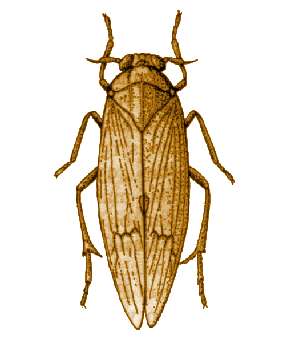Brown planthopper
Species of insect
The brown planthopper (Nilaparvata lugens) is a species of planthopper in the family Delphacidae. It is a major pest of rice crops in many parts of Asia, causing significant damage and yield loss.
Description[edit | edit source]
The brown planthopper is a small, brown insect that measures about 3-4 mm in length. It has a slender body and long legs, which allow it to jump considerable distances. The wings are transparent with brown veins, and the insect can be either short-winged (brachypterous) or long-winged (macropterous).
Life Cycle[edit | edit source]
The life cycle of the brown planthopper includes the egg, nymph, and adult stages. Females lay eggs in the leaf sheaths of rice plants. The eggs hatch into nymphs, which go through five instar stages before becoming adults. The entire life cycle can be completed in about 25-30 days under optimal conditions.
Habitat and Distribution[edit | edit source]
The brown planthopper is primarily found in rice paddies and is distributed across many rice-growing regions in Asia, including China, India, Indonesia, Japan, Korea, Philippines, Thailand, and Vietnam.
Economic Impact[edit | edit source]
The brown planthopper is a significant pest in rice cultivation. It feeds on the phloem sap of rice plants, causing direct damage and transmitting plant viruses such as rice ragged stunt virus and rice grassy stunt virus. Infestations can lead to a condition known as "hopperburn," where the plants wilt and die, resulting in substantial yield losses.
Management and Control[edit | edit source]
Effective management of brown planthopper populations involves integrated pest management (IPM) strategies, including:
- Use of resistant rice varieties
- Biological control using natural enemies such as spiders, predatory beetles, and parasitoid wasps
- Cultural practices like proper water management and crop rotation
- Judicious use of chemical insecticides to avoid resistance development
Research and Development[edit | edit source]
Ongoing research aims to develop new methods for controlling brown planthopper populations, including genetic approaches and the development of new resistant rice varieties.
See also[edit | edit source]
References[edit | edit source]
Search WikiMD
Ad.Tired of being Overweight? Try W8MD's physician weight loss program.
Semaglutide (Ozempic / Wegovy and Tirzepatide (Mounjaro / Zepbound) available.
Advertise on WikiMD
|
WikiMD's Wellness Encyclopedia |
| Let Food Be Thy Medicine Medicine Thy Food - Hippocrates |
Translate this page: - East Asian
中文,
日本,
한국어,
South Asian
हिन्दी,
தமிழ்,
తెలుగు,
Urdu,
ಕನ್ನಡ,
Southeast Asian
Indonesian,
Vietnamese,
Thai,
မြန်မာဘာသာ,
বাংলা
European
español,
Deutsch,
français,
Greek,
português do Brasil,
polski,
română,
русский,
Nederlands,
norsk,
svenska,
suomi,
Italian
Middle Eastern & African
عربى,
Turkish,
Persian,
Hebrew,
Afrikaans,
isiZulu,
Kiswahili,
Other
Bulgarian,
Hungarian,
Czech,
Swedish,
മലയാളം,
मराठी,
ਪੰਜਾਬੀ,
ગુજરાતી,
Portuguese,
Ukrainian
Medical Disclaimer: WikiMD is not a substitute for professional medical advice. The information on WikiMD is provided as an information resource only, may be incorrect, outdated or misleading, and is not to be used or relied on for any diagnostic or treatment purposes. Please consult your health care provider before making any healthcare decisions or for guidance about a specific medical condition. WikiMD expressly disclaims responsibility, and shall have no liability, for any damages, loss, injury, or liability whatsoever suffered as a result of your reliance on the information contained in this site. By visiting this site you agree to the foregoing terms and conditions, which may from time to time be changed or supplemented by WikiMD. If you do not agree to the foregoing terms and conditions, you should not enter or use this site. See full disclaimer.
Credits:Most images are courtesy of Wikimedia commons, and templates, categories Wikipedia, licensed under CC BY SA or similar.
Contributors: Prab R. Tumpati, MD

